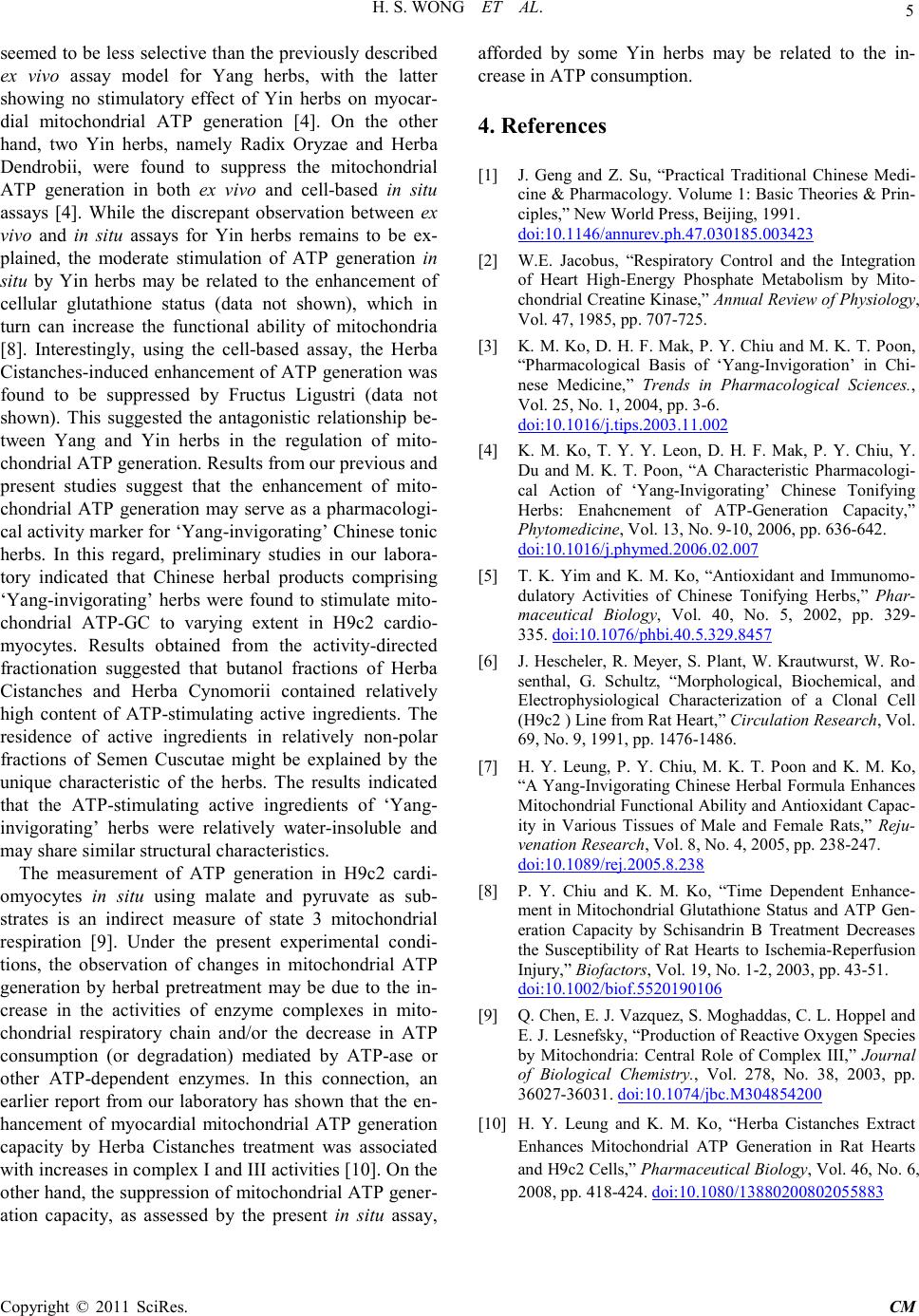
H. S. WONG ET AL.
Copyright © 2011 SciRes. CM
seemed to be less selective than the previousl y described
ex vivo assay model for Yang herbs, with the latter
showing no stimulatory effect of Yin herbs on myocar-
dial mitochondrial ATP generation [4]. On the other
hand, two Yin herbs, namely Radix Oryzae and Herba
Dendrobii, were found to suppress the mitochondrial
ATP generation in both ex vivo and cell-based in situ
assays [4]. While the discrepant observation between ex
vivo and in situ assays for Yin herbs remains to be ex-
plained, the moderate stimulation of ATP generation in
situ by Yin herbs may be related to the enhancement of
cellular glutathione status (data not shown), which in
turn can increase the functional ability of mitochondria
[8]. Interestingly, using the cell-based assay, the Herba
Cistanches-ind uced enhance ment of AT P generation was
found to be suppressed by Fructus Ligustri (data not
shown). This suggested the antagonistic relationship be-
tween Yang and Yin herbs in the regulation of mito-
chondrial AT P gene ration. Results from our p revious and
present studies suggest that the enhancement of mito-
chondrial ATP generation may serve as a pharmacologi-
cal activity marker for ‘Yang-invigo rat ing ’ Chine se tonic
herbs. In this regard, preliminary studies in our labora-
tory indicated that Chinese herbal products comprising
‘Yang-invigorating’ herbs were found to stimulate mito-
chondrial ATP-GC to varying extent in H9c2 cardio-
myocytes. Results obtained from the activity-directed
fractionation suggested that butanol fractions of Herba
Cistanches and Herba Cynomorii contained relatively
high co ntent of ATP -stimulating active ingredients. The
residence of active ingredients in relatively non-polar
fractions of Semen Cuscutae might be explained by the
unique characteristic of the herbs. The results indicated
that the ATP-stimulating active ingredients of ‘Yang-
invigorating’ herbs were relatively water-insoluble and
may share similar structural characteristics.
The measurement of ATP generation in H9c2 cardi-
omyocytes in situ using malate and pyruvate as sub-
strates is an indirect measure of state 3 mitochondrial
respiration [9]. Under the present experimental condi-
tions, the observation of changes in mitochondrial ATP
generation by herbal pretreatment may be due to the in-
crease in the activities of enzyme complexes in mito-
chondrial respiratory chain and/or the decrease in ATP
consumption (or degradation) mediated by ATP-ase or
other ATP-dependent enzymes. In this connection, an
earlier report from our laboratory has shown that the en-
hancement of myocardial mitochondrial ATP generation
capacity by Herba Cistanches treatment was associated
wit h increases in complex I and III activities [10]. On the
other hand, the suppression of mitochondrial ATP gener-
ation capacity, as assessed by the present in situ assay,
afforded by some Yin herbs may be related to the in-
crease in ATP consumption.
4. Referen ces
[1] J. Geng and Z. Su, “Practical Traditional Chinese Medi-
cine & Pharmaco logy. Vol ume 1: Basic Theories & P rin-
ciples,” New World Press, Beij ing, 1991.
doi:10.1146/annurev.ph.47.030185.003423
[2] W.E. Jacobus, “Respiratory Control and the Integration
of Heart High-Energy Phosphate Metabolism by Mito-
chond rial Creat ine Kinase,” An nual Review of Physiology,
Vol. 47, 19 85, pp. 707-725.
[3] K. M. Ko, D. H. F. Mak, P. Y. Chiu and M. K. T. Poon,
“Pharmacological Basis of ‘Yang-Invigoration’ in Chi-
nese Medicine,” Trends in Pharmacological Sciences.,
Vol. 25, N o. 1, 2004, pp. 3-6.
doi:10.1016/j.tips.2003.11.002
[4] K. M. Ko, T. Y. Y. Leon, D. H. F. Mak, P. Y. Chiu, Y.
Du and M. K. T. Poon, “A Characteristic Pharmacologi-
cal Action of ‘Yang-Invigorating’ Chinese Tonifying
Herbs: Enahcnement of ATP-Generation Capacity,”
Phytomedicine, Vol. 13, No. 9-10, 2006, pp. 636-642.
doi:10.1016/j.phymed.2006.02.007
[5] T. K. Yim and K. M. Ko, “Antioxidant and Immunomo-
dulatory Activities of Chinese Tonifying Herbs,” Phar-
maceutical Biology, Vol. 40, No. 5, 2002, pp. 329-
335. doi:10.1076/phbi.40.5.329.8457
[6] J. Hescheler, R. Meyer, S. Plant, W. Krautwurst, W. Ro-
senthal, G. Schultz, “Morphological, Biochemical, and
Electrophysiological Characterization of a Clonal Cell
(H9c2 ) Line from Rat Heart,” Circulation Research, Vol.
69, No. 9, 1991, pp. 1476-1486.
[7] H. Y. Leung, P. Y. Chiu, M. K. T. Poon and K. M. Ko,
“A Yang-Invigorating Chinese Herbal Formula Enhances
Mitochondrial Functional Ability and Antioxidant Capac-
ity in Various Tissues of Male and Female Rats,” Reju-
venation Research, Vol. 8, No. 4, 2005, pp. 238-247.
doi:10.1089/rej.2005.8.238
[8] P. Y. Chiu and K. M. Ko, “Time Dependent Enhance-
ment in Mitochondrial Glutathione Status and ATP Gen-
eration Capacity by Schisandrin B Treatment Decreases
the Susceptibility of Rat Hearts to Ischemia-Reperfusion
Injury,” Biofactors, Vol. 19, No. 1-2, 2003 , pp. 43-51.
doi:10.1002/biof.5520190106
[9] Q. Chen, E. J. Vazquez, S. Moghaddas, C. L. Hoppel and
E. J. Lesnefsky, “Production of Reactive O xygen Species
by Mitochondria: Central Role of Complex III,” Journal
of Biological Chemistry., Vol. 278, No. 38, 2003, pp.
36027-36031. doi:10.1074/jbc.M304854200
[10] H. Y. Leung and K. M. Ko, “Herba Cistanches Extract
Enhances Mitochondrial ATP Generation in Rat Hearts
and H9c2 Cells,” Pharmaceutical Biology, Vol. 46, No. 6,
2008, pp . 418-424. doi:10.1080/13880200802055883